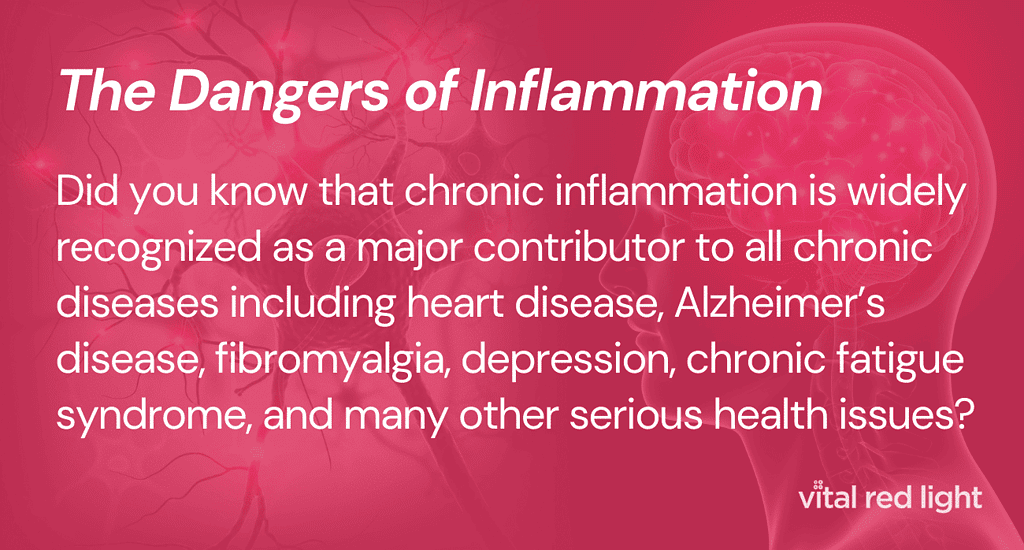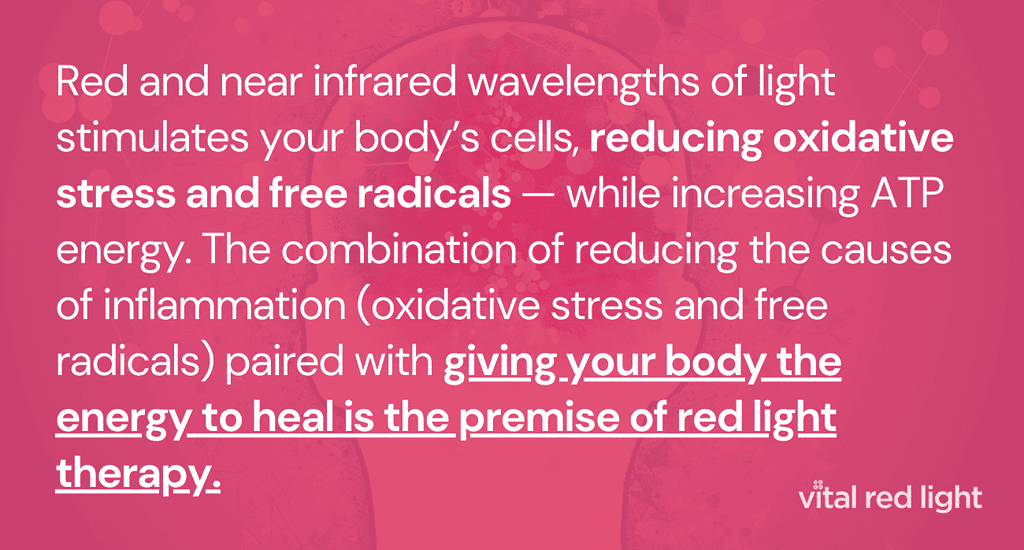Red Light Therapy for Inflammation: Does it Work & Which Device is Best?

By Leslie K. Hughes
Inflammation is an issue that plagues America. In nearly every chronic disease that affects over 130 million people in the United States, inflammation is a contributor. It is a problem that many people live with, but don’t realize the importance of getting a handle on it – until it’s too late. Studies show that inflammation can lead to all sorts of health issues including arthritis, heart disease, stroke, and more. [1]
To make matters worse, many of the non-steroidal anti-inflammatory medications given to people who suffer from chronic inflammation put them at higher risk of both heart attack and stroke. Thus, it is vital that people start exploring alternative treatments for reducing inflammation.
One such alternative that has shown great results is red light therapy. This approach to helping inflammation is a natural and effective treatment for this issue that doesn’t come with the long list of risks and side effects that pharmaceuticals do. Does red light therapy work for inflammation, though? And if so, what is the best red light therapy for inflammation?
Don’t worry – we’ve got the answers you’re searching for here in this complete guide. We’re going to cover everything you need to know about red light therapy for inflammation in this article. Let’s not waste any time!

What is inflammation?
Inflammation plays an important role in your body. It is how your body responds to danger in all kinds of forms – from environmental toxins to lack of sleep, poor food quality to dehydration, alcohol to chemical irritants, stress to germ exposure, and more.
Inflammation is your body’s reaction to damage and is key to healing and injury repair; it is more than just a symptom and can point to the fact that there is something wrong in your body that requires attention. Two different types of inflammation exist in the body: acute inflammation and chronic inflammation. Let’s get into more detail about what differentiates the two.
Acute inflammation is fairly common.
This type of inflammation is the one that most people are familiar with. It’s when you see your body swell, turn red, get warm, and experience pain as a result of an injury. Take banging your knee or cutting your finger, for example.
When something like this happens, your body’s immune system dispatches an army of white blood cells to surround and protect the area, thus creating visible redness and swelling. This process looks very much the same for the flu or any other illness.
In these situations, inflammation is essential to your health and is what you can thank for helping your body recover from infections, viruses, and other injuries. Acute inflammation is a good kind of inflammation.
On the other hand, chronic inflammation can cause issues.
If only acute inflammation was all that existed, we wouldn’t have some of the severe health issues that we do today. We would have just the right amount of inflammation for the right period of time to help our bodies heal, and then disappear.
But, unfortunately, not all inflammation is good. The bad kind of inflammation is known as chronic inflammation. This occurs when the inflammation becomes too great and remains for too long. Why is this a problem? Because this lingering inflammation continues to trigger your immune system to keep producing white blood cells because your body thinks it’s under constant attack.
This means that your immune system is fighting non-stop to keep you safe. Though this may sound like a good thing, it is not. It poses the risk that your excess white blood cells start attacking other healthy tissues and organs. [2] Harvard Health uses the example of an overweight person suffering from chronic inflammation.
“If you are overweight and have more visceral fat cells – the deep type of fat that surrounds your organs – the immune system may see those cells as a threat and attack them with white blood cells. The longer you are overweight, the longer your body can remain in a state of inflammation.” [2]

The dangers of chronic inflammation are something to be aware of.
Did you know that chronic inflammation is widely recognized as a major contributor to all chronic diseases including heart disease, Alzheimer’s disease, fibromyalgia, depression, chronic fatigue syndrome, and many more? [3] Chronic inflammation occurs when your body thinks you are in constant danger.
This constant inflammatory state is harmful and is often called the root cause of disease. Chronic inflammation is present in many medical conditions including cancer, diabetes, heart disease, stroke, arthritis, poor gut health, and poor COVID-19 outcomes.
And, unfortunately, inflammation can move throughout the body and wreak havoc all over. Though this all sounds pretty dire, don’t worry – there is hope and it comes in the form of red light therapy. This approach to healing addresses chronic inflammation on the cellular level.
Does red light therapy work for inflammation?
If you’re not familiar with red light therapy, the short version is this: light therapy delivers safe, concentrated wavelengths of natural light to your skin and cells.
These red and near-infrared wavelengths of light stimulate those cells and reduce oxidative stress, so your body is able to make more usable energy to power itself. This increases function, speeds healing, and lowers inflammation and pain, as demonstrated in numerous peer-reviewed studies. [4]

How red light therapy works for inflammation
How does red light therapy work, exactly, to address inflammation?
Red light reduces inflammation by stimulating cellular repair and regeneration. A relaxed inflammatory response can accelerate healing. While acute inflammation is a necessary part of the healing process (without it, wounds or cuts would not heal), chronic inflammation and dysfunctional inflammation cause delays in healing. [5,6]
Most of red light’s effects are through the cells’ mitochondria absorbing light. In essence, what this all boils down to is that near-infrared and red light therapy help mitochondria produce more energy, decrease inflammation, and help build the cell defense systems to increase resiliency.
According to Dr. Michael Hamblin of Harvard Medical School and Massachusetts General Hospital, one of the leading photomedicine researchers, natural red and NIR light are, “a very mild form of stress that activates protective mechanisms in the cells … for instance, when longer wavelengths or visibly red light hits the skin, it nudges mitochondria to make energy more efficiently and boost production of healing anti-inflammatories or disease-fighting antioxidants.” [7]
Red light therapy can treat inflammation across the body.
Recent studies have shown that red light therapy is promising as a treatment for chronic inflammation. In certain conditions, such as rheumatoid arthritis, psoriatic arthritis, juvenile idiopathic arthritis, and many others, the use of red light therapy offers a viable alternative to anti-inflammatory medications with fewer side effects.
In a study, seven patients with bilateral Achilles tendonitis were exposed to red light therapy. After being exposed, it was found that red light therapy reduced inflammation and pain in all 14 tendons. They concluded that red light therapy has a potential role in the management of inflammatory conditions. [6]
It can help with exercise, too!
Exercise therapy and red light therapy actually work synergistically in reducing inflammation, meaning that they improve each other’s effects. [6]
So if you’re exercising without incorporating red light therapy into your workout routine, you are missing a major opportunity to reduce localized or systemic inflammation. A reduction in inflammation can help your injuries heal much faster if you decide to integrate red light therapy into your life.
A few inflammatory conditions red light therapy can help with
It’s no wonder more and more people are using red light therapy for inflammation. Red light therapy has the power to dramatically lower inflammation levels in the body. [5] This means that red light can be used to treat problems like osteoarthritis, joint injuries, and excessive swelling without any of the side effects that are commonly associated with inflammation-reducing non-prescription drugs such as NSAIDs. [6]
The following conditions that are connected with acute and chronic inflammation all prove to have promising results with the use of red light therapy treatment:
Arthritis
Asthma
Sinusitis
Muscular sprains
Fibromyalgia
Neuron inflammatory
disorders such as Alzheimer’s
Irritable bowel syndrome and colitis
Rheumatic condition

Want to transform your health? Get the best red light therapy for inflammation today!
Now that you understand the benefits of red light therapy for inflammation, it’s time to start looking for the device that’s right for you. That’s right – you can get a device and use it from the comfort of your own home. No need for a tanning salon red light therapy session!
You can learn specifically how to use red light therapy at home on our site. And while you’re there, grab one of our affordable and highly-effective at-home red light therapy devices.
We have a wide range of options to fit your specific needs – from our Vital Charge handheld device to our Vital Elite full-body device. All of our devices use medical-grade 5-watt LED lights and are FDA-cleared.
No matter what your goals are, you can make inflammation and pain things of the past with our near-infrared light therapy devices or full-body red light therapy devices!
Final thoughts on using red light therapy for inflammation
Inflammation is an important part of our life as it serves as a natural response to dangers that our bodies may encounter. However, it is important to not let acute inflammation become chronic inflammation, as that’s when this natural healing reaction transforms into a harmful one that can put the body at risk of serious health issues.
By living a healthy lifestyle and incorporating red light therapy for inflammation into your life, you are able to support your cells in doing their job of keeping your inflammation at a safe level and thus, keeping your overall health in an optimal place.
The only thing left to do at this point is to get the best red light therapy for inflammation at Vital Red Light. You’ll gain access to both portable red light therapy devices and red light therapy panels. You can also learn more about the benefits of red light therapy in our blog – including using red light therapy for weight loss or red light therapy for skin health. This revolutionary treatment is here to enhance your health and wellness in ways you never thought possible!
Citations:
[1] “Playing with the Fire of Inflammation.” Harvard Health, 12 Apr. 2021,
https://www.health.harvard.edu/staying-healthy/playing-with-the-fire-of-inflammation
[2] “Understanding Acute and Chronic Inflammation.” Harvard Health, 1 Apr. 2020, https://www.health.harvard.edu/staying-healthy/understanding-acute-and-chronic-inflammation
[3] Bjordal, J M et al. “A randomised, placebo controlled trial of low level laser therapy for activated Achilles tendinitis with microdialysis measurement of peritendinous prostaglandin E2 concentrations.” British journal of sports medicine vol. 40,1 (2006): 76-80; discussion 76-80. doi:10.1136/bjsm.2005.020842, https://www.ncbi.nlm.nih.gov/pmc/articles/PMC2491942/
[4] George, Sajan et al. “Effect of red light and near infrared laser on the generation of reactive oxygen species in primary dermal fibroblasts.” Journal of photochemistry and photobiology. B, Biology vol. 188 (2018): 60-68. doi:10.1016/j.jphotobiol.2018.09.004, https://www.ncbi.nlm.nih.gov/pmc/articles/PMC6214457/
[5] Chung, Hoon et al. “The nuts and bolts of low-level laser (light) therapy.” Annals of biomedical engineering vol. 40,2 (2012): 516-33. doi:10.1007/s10439-011-0454-7, https://www.ncbi.nlm.nih.gov/pmc/articles/PMC3288797/
[6] Alves, Agnelo Neves et al. “Effects of low-level laser therapy on skeletal muscle repair: a systematic review.” American journal of physical medicine & rehabilitation vol. 93,12 (2014): 1073-85. doi:10.1097/PHM.0000000000000158, https://pubmed.ncbi.nlm.nih.gov/25122099/
[7]Hamblin, Michael R. “Mechanisms and applications of the anti-inflammatory effects of photobiomodulation.” AIMS biophysics vol. 4,3 (2017): 337-361. doi:10.3934/biophy.2017.3.337, https://www.ncbi.nlm.nih.gov/pmc/articles/PMC5523874/



